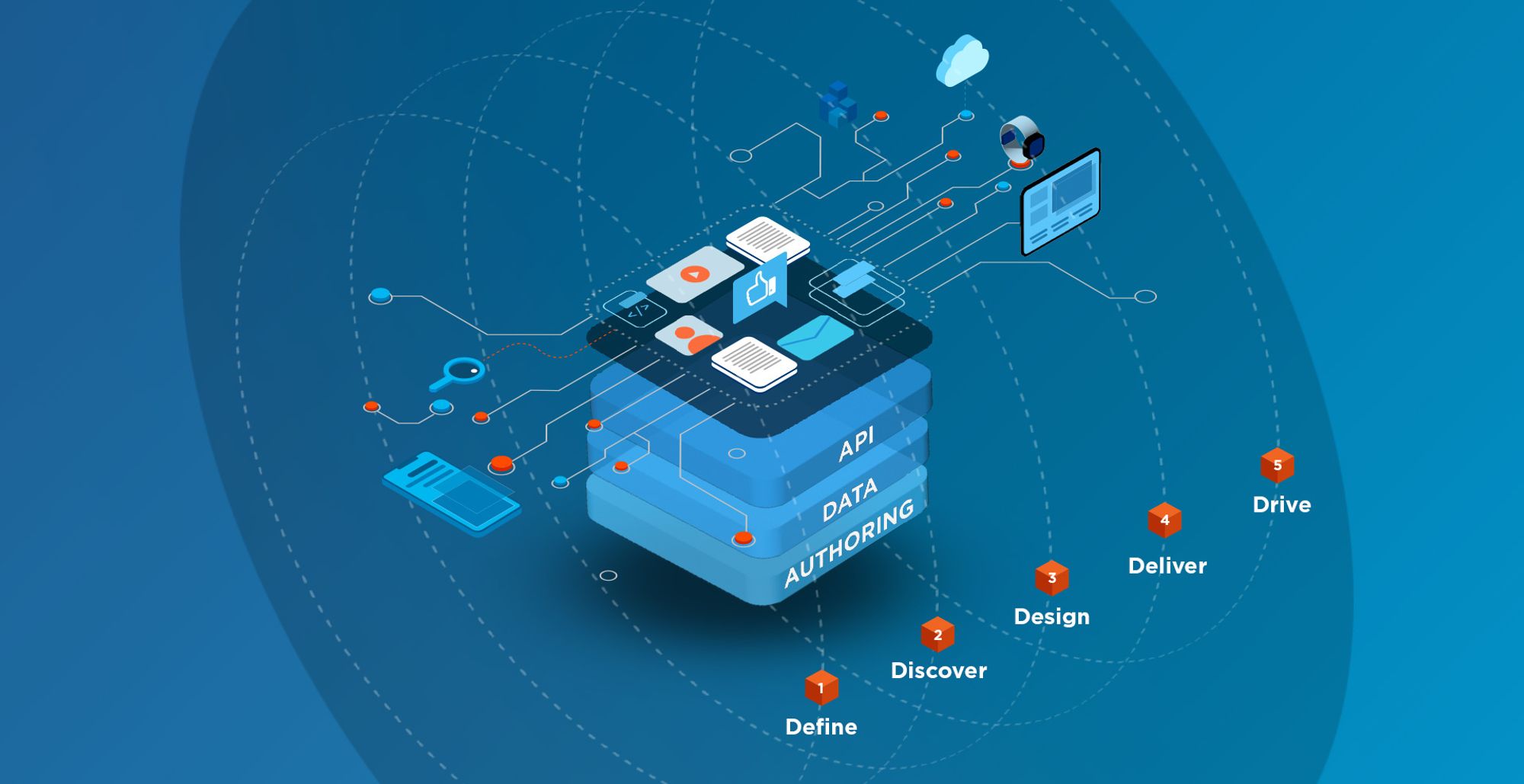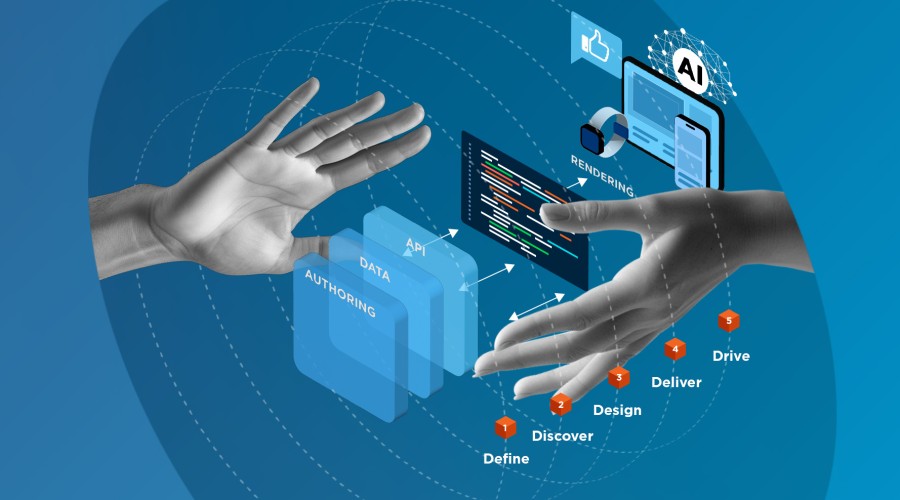A well-designed headless CMS offers a fully flexible content publishing experience with multiple benefits, but to unleash its full potential and ROI it needs to be designed with your organisation’s strategic user needs in mind.
If content is king, how your organisation plans to create, store, quality assure and manage it is critical. This planning forms a key part of how to decide which type of CMS to choose for your business and how it should be structured and maintained day-to-day and in the long-term.
We believe it takes a deeply user-centred design (UCD) approach to unleash the potential of headless CMS, or any CMS for that matter. Effectively integrating content strategy, SEO strategy and UX strategy into the very design of any CMS.
We call this methodology the UX Content Strategy Framework (UXCSF): it encapsulates all the facets of content, technology, and design.
We can think of how home organisations have a large content team of multiple writers, producers and other creatives. Others have a one-man band. Some have a centralised content marketing function through which all content is created. Others are fully decentralised with multiple editors from across the business, likely to be subject matter not content or communications experts.
Either way, there must be the right system in place to make sure the content is of the right type and high quality in the first place, so it’s right for the audiences it’s going to, isn’t being duplicated and can be easily accessed and found by the people who need it.
The particular structure of a headless CMS into three main components – content data repository(s), content delivery API(s) and front-end system(s) that presents content on different devices and channels – means considering your user needs and content resources upfront is vital.
Choosing and correctly structuring the right CMS can actively help your organisation maintain content quality and help you plan and resource how content is created. Whether that’s training up more subject experts, hiring more content designers, or baking content quality assurance into job roles.
Getting it wrong could mean that you’re unable to deliver the kind of brilliant omnichannel user experience that a headless CMS can potentially offer.
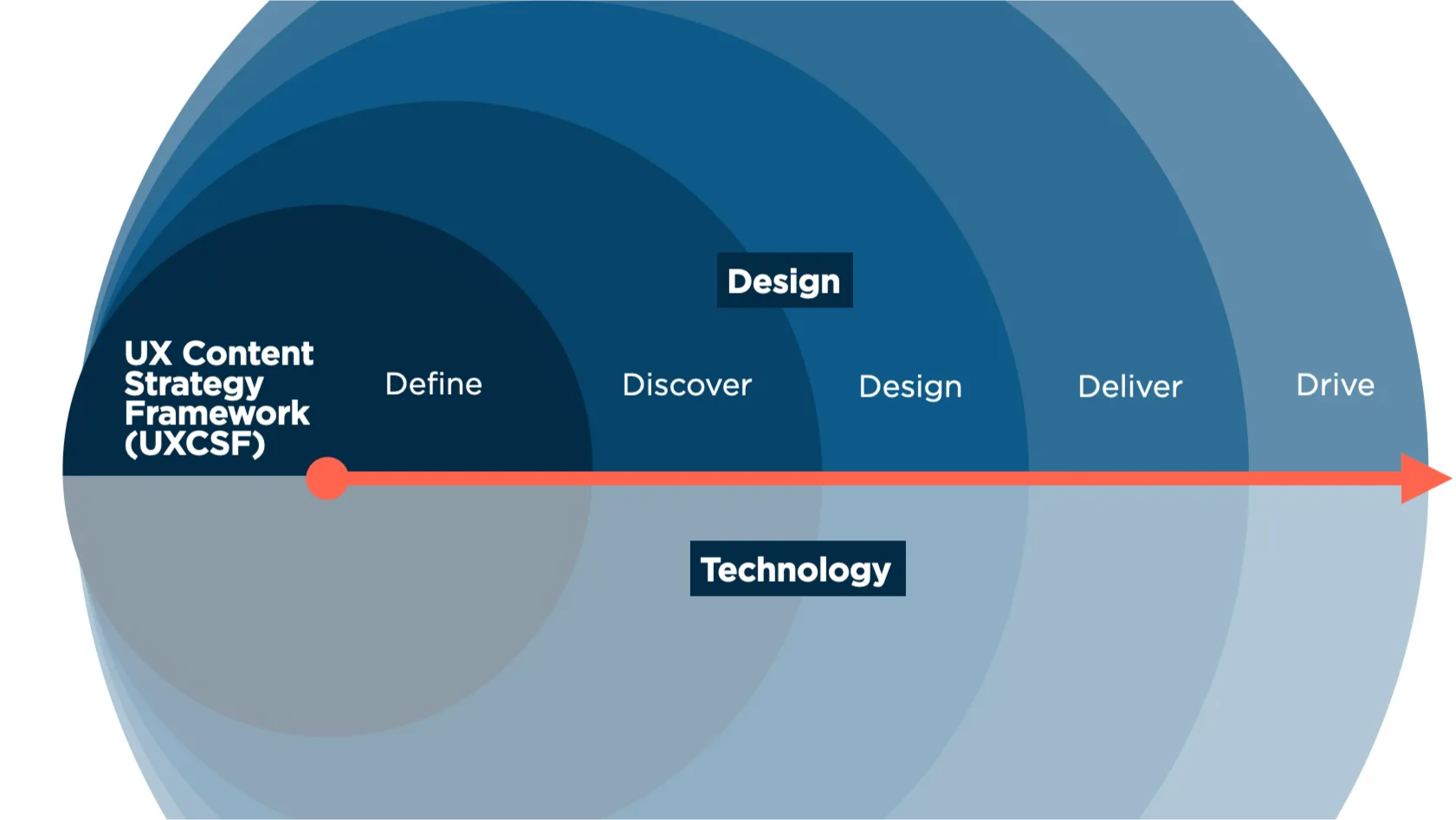
UX Content Strategy Framework (UXCSF) diagram. Cyber-Duck uses this model to intersect between user centeed design, governance, and technology to implement the right type of CMS solution for an organisation.
How to define business requirements for your headless CMS
Whether it’s part of creating a formal RFP/ITT in the first place or once you have an agency on-board to develop your headless CMS, large-scale innovation or transformation projects require a deep understanding of user journeys and requirements of customers, team members and third parties to really map out the ‘as-is’ and desired ‘to-be’ states.
Effectively, understanding where your content publishing experience is now, and where you would like - and need - it to be to deliver on your organisation’s goals and KPIs in future.
The starting point is often a Publishing Manifesto developed by the organisation’s leadership. A publishing manifesto will include key principles to help clarify what success looks like, the channel publishing requirements including what modalities are required (e.g. personalisation across channels), how search engines, for example, must relate to the content and what accessibility principles should be encapsulated and why.
Once these business requirements are understood, this key stakeholder vision forms a coherent set of principles to govern and strategise who the internal or external publishers are. The next step is to unpick how those principles need to be applied in practice. The learnings of which are critical to selecting the right CMS.
Aligning your user needs, technical requirements and information architecture
A starting point is mapping out service journeys to uncover user requirements around content. This can be challenging, requiring objective systems and design thinking expertise that can often be provided by external experts working closely with stakeholders to map out business objectives and service journeys together. Effectively looking at who, where and how content needs to be created, managed and used.
Traditionally, in monolithic CMS development, card sorting techniques are used to map out a detailed page-based information architecture (IA) and navigation system that clarifies how content will be accessed and searched and how users interact with the system.
Headless CMS requires us to do things differently.
In the headless word, content is no longer static web page outputs, like a blog post, a news item, a new product listing. Instead, content is (meta)data. Object and entity-based, with content structured and broken down into smaller chunks that can be assembled and presented to the user in any number of different ways to suit a mobile phone, smartwatch, social media feed or anything else for that matter. Think the difference between a carpentry workshop full of tools and materials you can use to build anything you want, versus being provided with a set of flatpacks.
This means the headless CMS information architecture mapping exercise is more granular, really digging into the taxonomy of your current (and desired) content. This will not only lead to a new IA but also to a way to establish the right content model(s) - understanding how content should be structured and what objects are needed.
These outputs set the direction for what the technology architecture needs to be and what headless CMS is right for your organisation.
Here, it’s vital to work with technology teams to establish what third party systems and technology are required, what type of integrations are needed and the type of publishing capabilities the business needs. Depending on what sort of content migration is required, the number of digital entities or repositories, a strong delivery and agile approach will be needed to define the acceptance criteria of what constitutes a successful content implementation strategy for launching the platform.
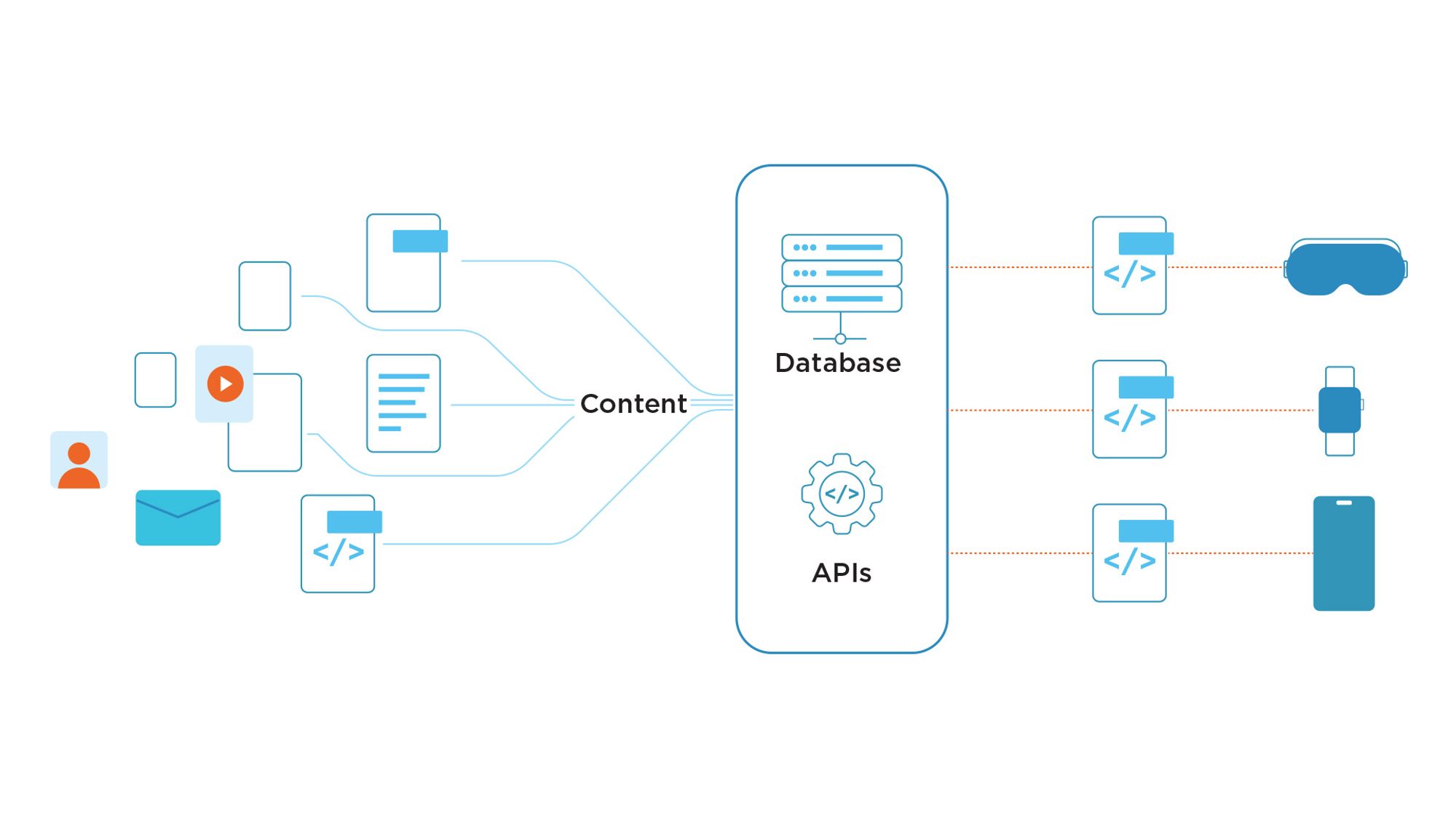
The structure of a Headless CMS.
Embedding governance in your headless content strategy
Defining a content strategy – how content is planned, created, delivered, and governed – whether its words, images or other multimedia objects – is the key to integrating the organisations aims and KPIs with content and desired user experience. Essentially, helping to uncover the organisation’s content models and bridging the gap between the ‘experience’ and ‘technology’.
But the importance of a vision around content governance at this stage cannot be understated. It’s relatively easy to start afresh with a new content framework. What’s challenging is maintaining a content strategy in the long-term as a business evolves and new people come and go.
Content governance includes rules on what is published, by who, where they publish, how they publish and who audiences are. This will clarify workflows and resourcing. The governance plan should also include champions with carved out time to manage the content framework moving forward and ensure the principles from the strategy are adhered to and updated.
Content audit– a backbone of your headless CMS discovery
Once your business, user, technical requirements and governance plan are defined, a deeper discovery process is then needed around content.
Typically, a content audit will augment a new IA. Within the audit, a content strategist and user experience designer will work with an SEO analyst to uncover every single content piece within an organisation’s existing content inventory. Often a data engineer will need to support here to ensure that all content repositories are identified to ensure the inventory is analysed in depth.
We’ve seen situations where clients have had content concealed in various systems such as microsites, apps, intranets and on social channels. Being able to query, log and reference to the existing content is a first step. There are various tools such as Google Search Console, GA, Screaming Frog and others built to do this.
Various analytics and SEO tools will also provide further data on how often the content is accessed and used, and if you have CRM data about the content, it can be further leveraged to provide a ‘true picture’ on the value of the content.
The content strategy will also consider links between the content and the publishing manifesto’s highlighted SEO objectives to ensure user intent from search engines is considered to guard against cannibalising your own search rankings by having too much duplication of content or keywords. Further analysis should be given to external content too, as it may link to existing content, whether valuable or outdated.
The content audit will end up analysing, categorising, tagging and - ultimately - rating existing content. Its aim is to extract and delineate the quality and ‘golden’ content from the weaker and outdated content. Depending on the publishing vision and KPIs, it may be needed to ‘cull’ content in bulk based on dates, relevancy, the new IA and the desired user experience.
Here is a good time to tag and organise content into themes and who the audience of the content is for. This can help later with CMS content modelling, taxonomies, and folksonomies (social tagging where users create tags or labels to identify a piece of content, for example #catsofinstagram) to ensure the content is as findable and accessible as possible. Ultimately the content audit should provide a plan on what content should be migrated, created or changed for the programme or project you are undertaking.
Content migration – a practical approach
The content audit, summarised into a plan of action, serves as the ‘manual’ for the content migration into a new CMS. At this point the developers will be deciding on the content types and data structures from a CMS perspective to ensure the new system is setup correctly to enable the content migration.
The content migration process must ensure the content is technically ready for the import. This import through various scripts and automation processes and tools will consider meta data, content formatting, converting content into objects, tagging, media import, cleansing content and data and ensuring existing content is editable and enriched within the new CMS.
Topics like SEO, linking, semantics and meta data will also be dealt within the content migration. If some of the content will be replaced by new content sources or personalisation variables, then this will also be dealt with at this point.
The developers will also need to consider templates and the established governance rules and how that will impact the implementation of the content platform and CMS.
Designing the content for the new platform
The design stage is critical as it includes designing all the templates from a design hierarchy (or information design) to ensure that all the templates, content, media and data is findable, indexable and integrable (with other tools and platforms like personalisation).
The templates will consider how the content can objectified to work with the CMS, search engines and third-party tools to ‘enrich’ the user experience. But a key objective is to ensure that visual content is not only usable, accessible but also formatted beautifully for the end user. This is where art direction, UI and content design come to play.
One of the key steps is to ensure that new and existing content is broken into semantical objects and data to enrich the user experience not only on the website but also on search engines, within AI tools like Google Gemini or ChatGPT. By constructing the content in a particular way, it is possible to develop search engine-rich or featured snippets. Other considerations for content design should also stem from other channels like social media.
Some of the key tenets of creating stellar content design is to use the core content model to figure out exact content requirements based on informed user research. Understanding and defining the tone of voice (ToV) in tandem with the brand strategy is also key to success.
From an accessibility point of view, it will also be required to define the tone and readability standards of the content depending on who the audience is. This is where models like Flesch-Kinkaid can help to assess and define the complexity of the language and consider the reading age levels, English literacy and whether the content is as accessible as possible for people with impairments. As an example, utilising PDFs for long-form content, or placing key content into graphics or tables can complicate the user experience for marginalised users.
After the core models are developed and populated, object orientated content should be created so it can be delivered to as many channels as possible including social media. At this point it is vital to consider content meta data, content display and the optional character and display mechanisms for each channel.
Design teams will generally work using Figma and can create multi-component layouts using real content that developers can immediately display within a headless environment.
Whilst the above happens, in parallel the Web Developers will start to setup the CMS, all the necessary fields and objects and ensure the functional requirements and acceptance criteria are considered.
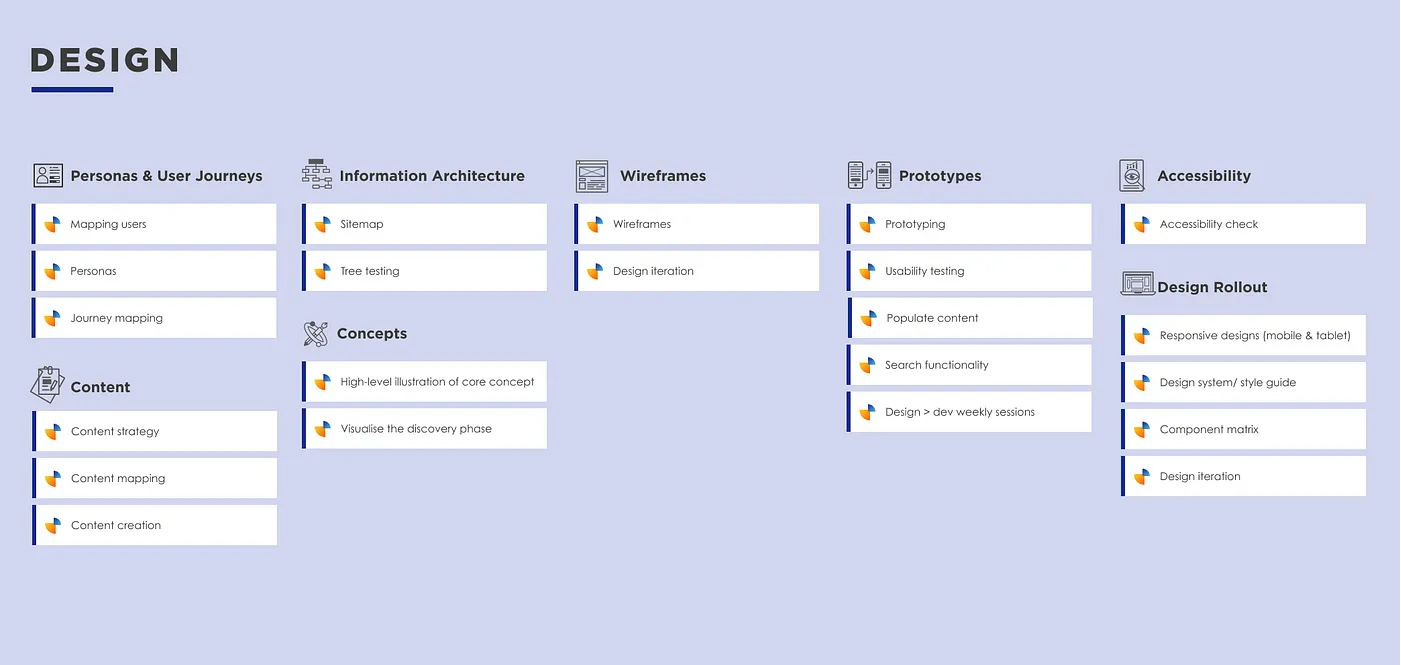
The design stage includes a detailed information architecture (IA) and content strategy, embracing the persona models and leading into functional prototypes
Delivering the new content platform
The developers will need to be heavily involved in setting up and configuring any CMS. This work requires quite a bit of setup and some customisation within the CMS to ensure that the migration is smooth and all the various modules are setup correctly. This work also entails setting up tracking with the analytics journeys to ensure that the right data is being captured and triggered for marketers to assess success.
A key part of the developer role is setting up the necessary integrations so where there is a digital experience platform (DXP), subscriptions system, e-commerce and personalisation functionality the developer will need to ensure everything is setup correctly.
But it’s not about just about handing over all the work to the developers. The content publishers and editors should be working ‘live’ with the developers to ensure that all content and design is compliant with the content strategy and UX strategy.
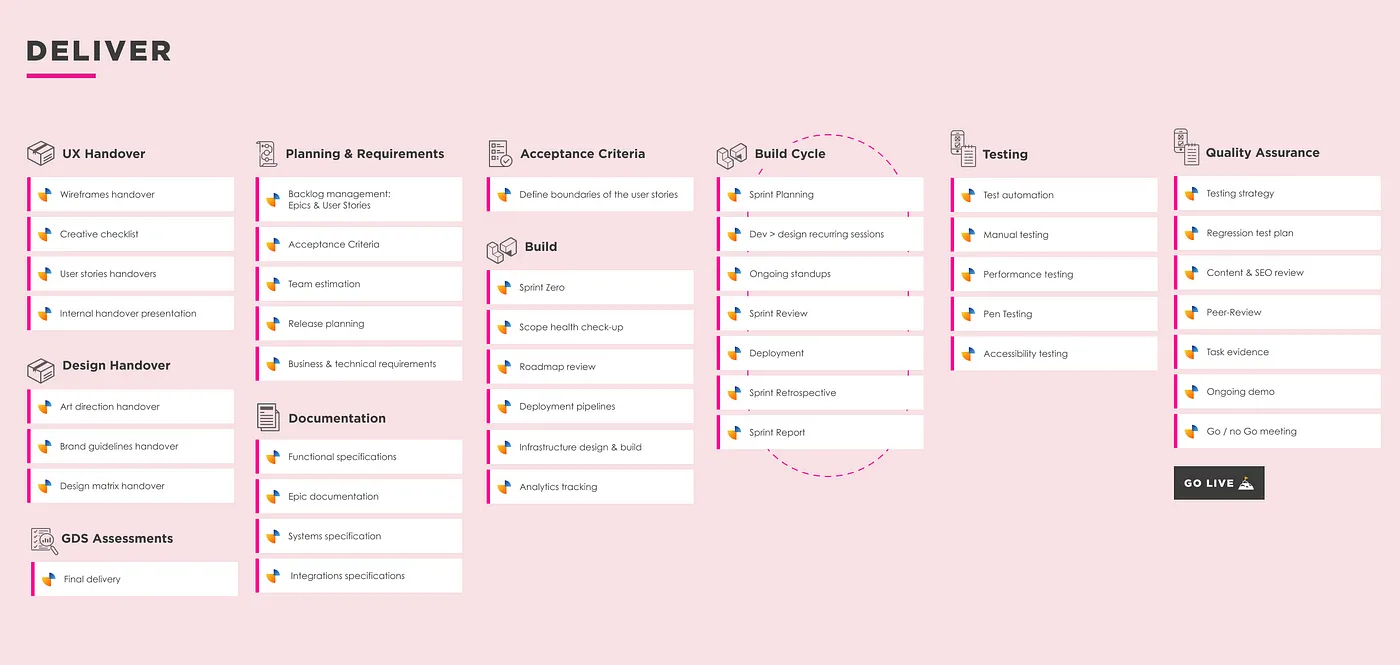
This is the stage where the content platform is at a stage or in a state that it is ‘delivered’ meaning that acceptance criteria is fully defined alongside the documentation and functional requirements and the developers are in the ‘build cycle’ which includes setting up tests and quality assurance.
Keep your headless CMS moving forward over time
Marrying a headless CMS with a user-centred content strategy requires careful planning, ensuring technology and design teams not only selecting the right technology, integrations and migrating everything in a compliant way, but also a priority on user research.
The content strategy needs to be delivered - and maintained - successfully across multiple channels whilst ensuring a seamless and consistent experience. After all, the goal of a successful content strategy is not just to give users the right content at the right time and minimise friction, but ensure that all types of user personas can ‘transact’ with an organisation successfully, whether they are external customers or internal teams.
It's important the right integrations from CRM to other systems and personalisation are set up correctly. The right technical setup alongside a modern and performant publishing experience for content publishers and editors ensures that content can be created effectively, efficiently, and enjoyably. This will create a culture where content publishing is a pleasure due to effective workflows, editing and approval processes.
And while not every business or institution has subscription, e-commerce or forms, every organisation needs to project the right type of information and data to maintain its brand image and credibility. If the technical publishing models are configured correctly and the content vision is implemented correctly through a successful content governance model, this is all possible.
For long term CMS success, organisations must ensure that there’s a responsible team who oversees content governance, the rules of publishing and ensure there are regular reviews of the content and that principles are adhered to across publishing, the channels, whilst ensuring regular reviews and audits.
On the technology side, the same is true. Once the right technology and platforms are selected, regardless of who the vendor is, the technology will need to be maintained to avoid technical debts. This is why it is important to select the right systems from the outset, and one that is supported by a community and a strong technical support team to ensure support and longevity.
In summary - user-centred solutions for user-centred problems
Businesses are spoilt for choice with CMS vendors offering fully-fledged headless content capabilities that can be enhanced by single customer view capabilities via customer data platforms (CDP) and DXPs to enable transactional type engagement (such as subscriptions, learning management and/or e-commerce). This, coupled with a myriad of mature APIs, single sign-on (SSO) facilities and omni-channel content distribution provide an almost endless list of considerations and technical options.
At its heart, how your organisation plans to create and manage the quality of your content is fundamental to your CMS choice. From our long experience delivering monolithic and headless CMS, we believe it’s not just a question of selecting a platform from the outset, but having a strategic and a cohesive design, content and technology approach to discover and build the right one.
Quite often, organisations will need to undertake journey mapping to uncover the content experience from start to finish encompassing not only end customers but also the publishing experience and how various integrations and APIs are leveraged across the board, encompassing data and utility. Once these blueprints are established it becomes possible to determine what type of content platform is required.
To then conceive a content strategy, audits and analysis will be required not only of content but also user research across customers, staff and suppliers. This coupled with a content governance model will ensure that a RACI matrix – setting out who is responsible, accountable, consulted and informed – is in place to help avoid the organisation getting into ‘content debt’ and ‘technical debt’ in future.
Key to this is creating a ‘customer’ centric culture where user research is central to multi-channel ‘content consumption’ and design. This continual investment in governance, technology upkeep and innovation ensures the right systems and human processes are being used so users are engaged and KPIs are being met with your headless CMS.
If you want to discuss the user-centred content challenges you’re facing with your business, do get in touch.
